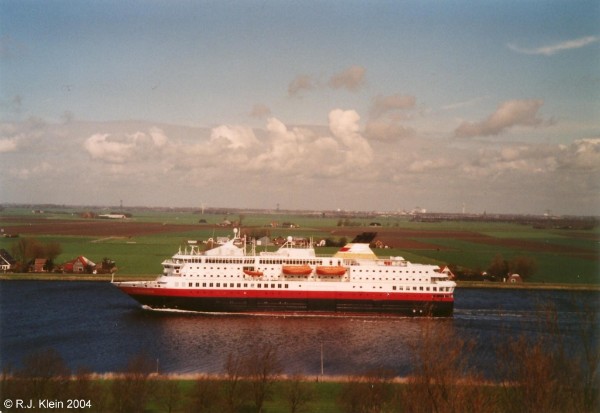Nordnorge
In the summer of 2004, the Hurtig Ruten ship Nordnorge visited The Netherlands. She is seen here passing the Spaarnwoude nature area on the Northsea Canal, between the village of Spaarndam and Amsterdam.

Nordnorge was built in a large class of newbuilds for the Norwegian Coastal Voyage in the 1990's, a time when there was a spectacular growth in tourism to Norway. As one of the best ways to see the country, the Hurtig Ruten combine knew they had to change their perspective, by looking far more to the touristic value of the service as to the traditional service itself. Untill the 1990's, the focus was mainly a ferryservice along the coast, connecting ports and villages from north to south. Tourism already was big business, but from the 1990's onwards, it became the most profitable.
Traditionally, the ships were built in Norway, so Nordnorge was ordered from the Kleven-yards at Ulsteinvik. She was built under yardnumber 266 and measures 123,30 meters in lenght. Her width is 24,50 meters and her tonnagemeasurement is 11.384. Her passengercapacity is 490 in cabins and 201 as deckpassengers (this is showing her role next to tourism, as a long-range ferry). Next to these passengernumbers, the ship also has a cardeck where 50 cars can be parked. There are six decks available to passengers and her crew capacity is 57. She of course flies the Norwegian flag with her homeport being Narvik. It was the second time that a ship was named Nordnorge in the companies history. Nordnorge is the most northern part of Norway.
Nordnorge was built for the company OVDS, that formed the Hurtig Ruten together with TFDS. For OVDS, another two sistership had been built one before Nordnorge named Richard With that was launched in 1993 and Nordkapp, that was launched in 1995. For TFDS, three sisters were also built named Kong Harald in 1992, Nordlys in 1993 and Polarlys in 1995.
The ships interiours are decorated in the art-deco and art-nouveau style and there is no dresscode, you can easily dine in slacks and poloshirt. Keep in mind where you are going, just bring clothes that are good for the destination, of course you do not go sightseeing the Arctic in hotpants and top... The policy aboard is no tipping, and because the Norwegian crew is paid well, they do not rely on those. So do not feel bothered when you don't pay tips, but when you are treated very well, it is of course a good way to show your gratitude.
Nordnorge herself was named at the 20th of march 1997 by Sissel Marie Ronbeck, the Norwegian Secretary of Transport and Communications. She immidiately started her services as a ferry, but she was also marketed with cruising and tourism in mind. Next to the traditional coastal voyages that are sailed during summer, the ship also undertook cruises in northern Europe. On cruises, of course there are no deckpassengers carried so the number of passengers carried is considerably lower then when she sails coastal voyages. Her cruises sometimes take her far away from the traditional route, in the northern winter even South America is seen by this small adventurous vessel. During these winter cruises, the passengernumber is limited to 350 and on the cardeck, the ship carries six inflatable landing craft. When sailing in the Antarctic on the 30th of january 2007, she was called to the assisitance of her sister Nordkapp, that had run aground. Nordnorge rescued all passengers from the ship and sailed towards the port of Ushuaia on the most southern tip of Argentina.
More dramatic was the rescue of the passengers and crew of the Explorer on the 23rd of november the same year. The 1969-built and 104-passenger ship ran into an iceberg and sank, also in the Antarctic waters. Also another cruiseliner, the National Geographic Endeavour came to the rescue, as well as the Argentinian Ushuaia and the Chilian Almirante Viel. Explorer sank some 20 hours after the collission.
On june the 16th of 2011, the longest TV-documentary ever (Hurtigruten - Minute by Minute) started to be broadcasted from the Nordnorge. Her total 134-hour voyage, that's five days, from Bergen to Kirkenes was filmed by the NRK2, one of Norway's national public television stations. Some 3,2 million vieuwers turned in, it is not known or they watched the whole thing...

